Industrial Revolution 4.0: Are we prepared for it?

From Current Affairs Notes for UPSC » Editorials & In-depths » This topic
IAS EXPRESS Vs UPSC Prelims 2024: 85+ questions reflected
The world is facing a continuous change due to the ever-increasing scientific and technological development and innovations. These developments have changed the political, social and economic lives of mankind.
The history in itself is defined by the improved technologies and new scientific discoveries like wheels, stone tools, steam engines, trains, automated machines, computers, etc. Now, we are at the cusp of the Fourth Industrial Revolution, the one that is dominated by technologies that far exceed human intelligence.
These innovations and technological growth may help mankind solve existing problems like poverty, death due to calamities, accidents, etc. These developments are fast-paced and ever-growing.
Currently, the laws and government policies are slow in preparing for these new technologies and scientific discoveries. The Indian Government must take immediate steps to make full use of the new and exhilarating possibilities arising out of the Industrial Revolution 4.0.

What is the Industrial Revolution 4.0?
- Industrial Revolution 4.0 is the term that is used to describe the transition from electronic-based industry to the one that is dominated by the fusion of new and emerging fields and ideas like ArtificiaI Intelligence, robotics, nanotechnologies, biotechnology, Internet of Things, fast-paced internet, automation of vehicles, green energy
- It is, in short, describes the huge changes that are brought about in the current era across the globe due to the discoveries and inventions in science and technology.
What was before the Industrial Revolution 4.0?
It is widely acknowledged that the Industrial Revolution was first commenced in Great Britain in 1700s.
- The industrial revolution spread across to the rest of Europe after it originated in Britain.
- This was mainly due to the efficiency and growth that were brought about by the new technologies emerging in the global market.
Prior to the industrial revolution, society was largely agrarian and rural in nature.
- The manufacturing processes were often undertaken in individual homes, with no coordination or disciple.
- The merchants supplied the raw materials to these cottage industries and collected the finished products.
- However, the supply was irregular because of the lack of organized manufacturing processes leading to inefficiency, losses and slow-paced growth.
Several innovative measures solved these problems.
- For example, in 1764, James Hargreaves of Great Britain invented Spinning Jenny. This enabled a single individual to produce multiple stools of threads simultaneously. This allowed for the faster and efficient manufacturing process.
- The efficiency of the spinning jenny was further improved by the British inventor Samuel Crompton. He combined the moving carriage of the spinning jenny and the rollers of the water frame to make a hybrid technology that overcame the existing limitations of the spinning jenny.
- Similar innovative solutions and technologies like this brought in the First Industrial Revolution that resulting in social and political changes across the world.
The Industrial Revolution is said to have undergone several phases.
- The First Industrial Revolution used steam power and water to run the machines during the manufacturing process. It was characterized by mass production, the establishment of factories and the use of steam-powered machinery.
- The Second Industrial Revolution used electric power to mechanise the production process. In this phase, many new resources were exploited like lighter metals, alloys, plastics, and new energy sources. There were also the emergences of new technologies like conveyer belts, electricity production, etc.
- The Third Industrial Revolution was driven by IT technologies and electronics. This paved the way for automation and other progress.
- These laid the foundation for the fourth Industrial Revolution that is dominated by AI, Robotics, etc.
How did the first Industrial Revolution affect the world?
- The First Industrial Revolution promoted a change that replaced agrarian and handicraft driven economy to a one that is dominated by the machine-driven economy.
- This lasted from 1760 to 1840.
- Many nations, due to the industrial revolution faced prosperity and economic development.
- The technological development helped enable mass production in a very short duration of time. This, in turn, saved time, human error, cost of the production, etc.
- This revolution initiated new ideas and perspectives that changed the world socially, economically and politically.
Read more about it: The Industrial Revolution
How the First Industrial Revolution affected India?
- As mentioned before, it is believed that the Industrial Revolution first originated in Great Britain.
- Later, it spread across many parts of the world due to the prosperity it created for Great Britain.
- However, to India, it came very late due to the strained relationship between Great Britain and India (a colony of Great Britain).
- India during that time, despite being a colony of Great Britain, dominated the textile market across the globe in the 18th
- However, India’s textile industry took a hit as the result of the Industrial Revolution in Great Britain.
- The use of steam power in the British mills reduced the cost of British cotton by 85%.
- This made Britain the largest exporter of cotton textile.
- The colonial government, in order to maintain Great Britain’s position in the textile industry, had imposed tariffs and other trade restrictions on the Indian textile industries.
- Further, the British also exported their finished textile products to India.
- This ultimately deindustrialized India and made it more of an agrarian society.
- The Colonial government also fixed laws that will force the Indian farmers to cultivate more cotton crops rather than food crops.
- This allowed for the increased raw materials for the British textile industries.
- However, for India, it was a great loss as it faced many large scale famine and poverty due to the inconsiderate government policies.
- The Industrial Revolution came to India in 1854 when the first steam-powered cotton mill was established in Bombay.
- However, the growth was slow and it was not enough to address the economic crisis faced by India under the British rule.
Read more about it: The Economic Impacts of British Colonial Rule in India.
How did India utilize the third Industrial Revolution?
- The third Industrial Revolution involved the emergence of computers, information and communication technologies, and the internet.
- Indian Economy is currently dominated by the IT Sector that came as the result of the Third Industrial Revolution.
- A large chunk of the Indian GDP is contributed by this sector.
- However, though this revolution increased India’s Economic Growth, it was able to employ only a small portion of the Indian population.
- Many were still dependent on the agricultural sector that gives very minimum returns.
- It is essential for India to make an effort to utilize the fourth Industrial Revolution to overcome the shortcomings like unemployment, poverty
How is India utilizing the trend of the Fourth Industrial Revolution?
The Indian Government has already taken measures to make full utilization of emerging technologies.
The Indian Government has institutionalized the concept by establishing the Centre for the Fourth Industrial Revolution.
- It is a hub for global cooperation to develop policy frameworks and collaborations that generate and accelerate the benefits of the present era’s technological developments and scientific discoveries.
- This was an initiative of the World Economic Forum.
- India is one of the four countries that have such centres. The other countries that hold these centres include the US, China, and Japan.
The Indian Government has also taken various government initiatives to promote Artificial Intelligence.
- The current Union Budget focuses on the promotion of the Electrical Vehicles that reduces the dependence on petrol and diesel and also promoted zero-emission of the carbon dioxide – the major contributor for the global warming and climate change.
- The government is also encouraging the use and promotion of unconventional and eco-friendly sources of energy in the manufacturing processes.
- More than 80% of the fuel is being imported by India. The promotions of eco-friendly energy sources help the government overcome this shortcoming.
What are the benefits of the Industrial Revolution 4.0?
- It helps relieve poverty and improve people’s standard of living.
- With Artificial Intelligence and fast-paced internet like 5G, there will be better diagnosis, cheaper and better medical services.
- The emergence of new and innovative technologies helps undertake better security, surveillance and search and rescue operations.
- India has currently announced a new drone policy that allows for efficient security, traffic, and mapping.
- It will help connect every last village in the country to ensure better government services and improved infrastructure for all.
- AI will play a significant role in changing the lives of specially-abled people.
- It promotes ease of living and ease of doing business.
- The improved early warning systems, weather forecasting systems, etc., assure improved disaster management, reduction of causality, faster evacuations, etc.
- The improvement in the fields of biotechnology, AI, pest control mechanism, innovative irrigation systems, etc., allows for increased crop production.
Way Forward:
The above-mentioned benefits are very few among the vast opportunities that exist within the Industrial Revolution 4.0. Currently, India is facing a massive unemployment crisis. With the emergence of new technologies, new skills are required to man these technologies. As a result of this, many may lose their jobs or won’t have the skills that are in demand.
Industrial Revolution 4.0 can become a liability if proper government measures aren’t taken to reduce the unemployment rate. However, if the Government takes the needed initiatives to make full use of the huge population and the technologies arising from the Fourth Industrial Revolution, India will soon become a highly developed economy.
Article by: K.G.Karishma
Must-read articles related to this topic:
- Artificial Intelligence – Everything you need to know.
- Globalization 4.0 – What does it mean? & How will it affect India?
If you like this post, please share your feedback in the comments section below so that we will upload more posts like this.



Please make this audio enabled
tq